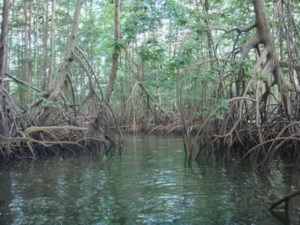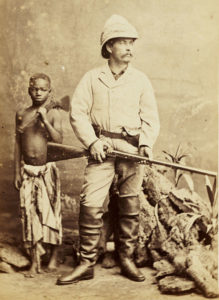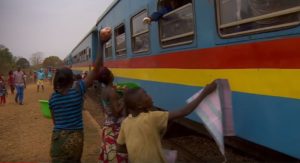Taking a boat up the Congo, river is an amazing way to see how the country has been shaped by this huge beast of a river.
The Congo is a beautiful and resource rich country, but the majority of people are extremely poor. With the current outbreak of Ebola and the continual threat of violence, the country struggles to keep on a harmonious path.
On this trip, we followed the great Congo river from its mouth all the way to Kisangani. This is where virtually all river traffic stops. The river is so huge that it crosses the equator twice and with all its tributaries, is three thousand kilometers long.
Starting Out On The Boat On The Congo River
Starting at the mouth of the river, we hired a boat and guide in Soyo. We gingerly made our way through the mangrove swamps that encompass the beginning of the river system, thinking about how the early explorers must have felt as they made their way up this famous river.
In less than 100km from the mouth of the river, there is an obstacle which would take the early explorers centuries to get around. On the other side of the port town Boma, there are voracious rapids which make passing by boat impossible.

The rapids at Boma meant that the city grew into a major powerhouse as a center of a trade of slaves and ivory in return for guns.
The Town Of Boma
In the town of Boma, there are plenty of statues of Henry Morgan Stanley. He was the first man to traverse the length of the Congo in order to open up the interior for exploitation. After being declined by the English Crown to colonise the region, he managed to convince the Belgian King Leopold to exploit the Congo. This in turn, became the king’s private colony and the Congo free state was born. And Boma became its capital.
The one thing that is striking about the Congo is the amount of resources the country has. These are in very high demand all over the world. For example, the Congo produced the majority of the bullets used in the First World War as well as the uranium which was used to make the atom bomb. Not to mention the amount of copper, gold and diamonds which the country possesses. There is however one renewable source, and that is water. If the Congo could build a hydro plant the other side of Boma to take advantage of the rapids, it would be able to provide twice as much power as any other hydro plant on earth. It just goes to show how damaging the cycle of corruption is for the country.
However, we were on a mission, and to circumvent the rapids we took the railway which was built in the 1890s. The trains only run once a week, so this is when villagers come out to sell as much as they can, which makes for a very raucous affair.
Arriving in the madness of Kinshaha
We eventually arrived in the capital, Kinshasha. This is one of Africa’s fastest country cities. It’s a brash city and nothing demonstrates this more than the Sapeurs: a flamboyant sub-culture which grew dramatically in the 1960s due to their fight for self expression. They were told that dressing in a western style was not permitted because it was direct link to its colonial past by the country’s then king. This is the result!

The Sapeurs – Photo Latinglam
Onwards To Mbandaka
From Kinshasha, we took the boat up the Congo river on a long journey over the equator to the next major port, Mbandaka. For a country with so few roads, the Congo river is the main highway for the country. This has paved the way for great barges which act as mini villages that take people across the country. Locals eat and sleep on them while they are taken from Kinshasha to Kungani, making many stops along the way.
As much as Congolese society revolves around the river, a very different society lives deep in the forest. The Pygmy people are an ethnic group living in a very different fashion to the average Congolese. They themselves have suffered great hardship, especially from King Leopold.
The Fishermen Of Kisangani
From Mbandaka, we took the northern tributary through Yangami and on to Kisangani, which is where all river traffic ceases as once again, rapids block the way. The water here also provides great opportunities for Yangami fisherman to help them with their catch. We also witnessed an initiation of sorts, where children of no more than ten years old are thrown into the water and expected to navigate themselves to safety.

Fishermen is the strong currents on the Congo river. Photo – Pinterest
Looking For Gorillas
From Kisangani, we then took to the road and made our way to see something truly remarkable in Kahuzi-Biega National Park. This park is home to a critically endangered species called the Eastern Lowland gorillas. There are many families of gorillas in the forest but only four families that have been habituated, meaning that they won’t attack humans. Following the tracks of their bamboo shoots left behind, and after a few hours hiking, we got our first glimpse only a few meters ahead…

Only 5000 Eastern gorillas left in a fraction of the land they used to inhabit. Photo NBC
The Congo is a vast and beautiful country, but it has had a troubled past from the days of King Leopold to the latter Congolese leaders that have exploited the land’s incredible natural resources. Elections are in the process of happening, but with questions marks over its legality to be free and fair, it may just continue its vicious cycle of poverty and war.




